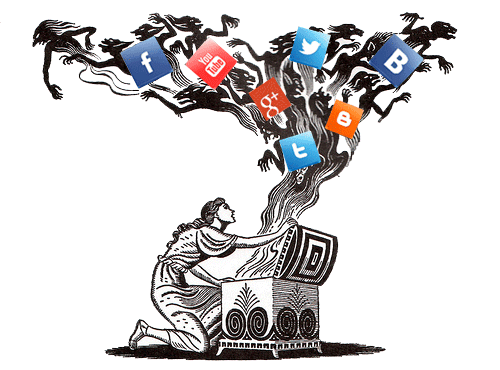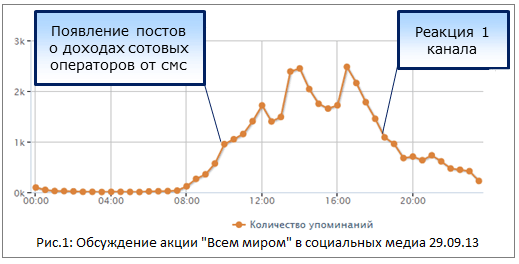Transformation of threats in the information space: from technological to social
Checkin is an invariable part of business lunch, and VKontakte “everything is complicated with ..”. And are you still worried about “big brother”? Why "spy" for the population, if people themselves tell everything about themselves and their loved ones? Is it enough today to protect closed data from leaks when the analysis of open data tells an order of magnitude more? How to protect yourself from the "open data" - stuffing false information, black PR, propaganda?
This article is written on the report of our colleagues at the interregional conference on Information Security, held in late October 2013. The considered cases are based on real events, and all information for them was obtained from open sources.
Over the past year or two, the concept of "INFORMATION SECURITY" has expanded considerably: humanity has entered an era of excessive informational openness , which opened the Pandora's box of the latest information threats on the Web. The article discusses the new paradigm of "INFORMATION SECURITY" of the modern world.

')
Want to look into Pandora's box? Then follow the cat.
To appreciate the grafomanism of humanity, consider the scale: worldwide, 1 million documents are produced in the “classic” media per day, while the generation of public user content (tweets, posts and comments in blogs, forums, social networks, reviews services) exceeds 1 billion a day, and the annual global increase in user content is 25%.
The development of this process in Russia is also impressive: we write 20 million messages per day (250 messages per second), and the monthly active audience (that is, those who left at least one public message) exceeds 30 million people . The population of a city, a region, an entire country is essentially becoming a unified information network for responding and disseminating information.
The paradigm of Information Security that we are accustomed to places at the forefront the PROTECTION of closed data. A new paradigm, firstly, is expanding due to open data, and secondly, it focuses attention on operational ANALYSIS and DECREASE of information attacks.
Technological (classical, basic) levels of information security - protection of classified information :
New, social levels of information threats - through the analysis of open information :
Against a spear, we need a shield, against socio-informational threats — new tools of operational psychosociology, which we still have to invent names.

Below are a few case studies that show approaches to identifying the most common information threats at different social levels: from person to company to international conflicts.
Case refers to a recent action - the All World telethon that was conducted by Channel One on September 29. The purpose of the action was in a powerful information message, prompting the population to make donations in favor of flood victims in the Far East. The collection of funds was carried out through SMS and electronic payment systems.
In general, the action was successful and was accompanied by an active discussion in social networks: from September 26 to September 30, 43,176 messages were published on the topic from 29,742 authors. However, it was an active discussion of the action, or rather the lack of monitoring of this discussion and led to a problem that prevented receiving the maximum possible amount of donations.
In the morning of September 29, unreliable information was published in social media that cellular operators will take half of the donations sent via SMS, and this information, picked up by popular Twitter users, initiated an avalanche-like discussion in social networks: about 5% of all messages about the action - this is what nuance. This was one of the main reasons that kept people from sending SMS messages.
The “Channel One” reaction appeared with a significant delay, when unreliable information was already widely distributed.

Thus, the social media information space has demonstrated its strength: the appearance of inaccurate information had a sharply negative impact both on the image of the action and the organizers, and on the amount of funds raised.
The organizers of the rally and the “big three” gave a detailed explanation in Vedomosti only the next day, which could not remedy the situation - the time was already lost.
Conclusions: Information flow in social media, accompanying public figures, companies and, moreover, specialized actions, is an important element of influencing public opinion. Therefore, it is necessary to carry out real-time monitoring of the reaction , especially in the case of “social television”, when viewers throw out emotions in the course of a program, performance, contest, show, televised debate.
CASE 2. WORLD (POLICY, LONG-TERM TRENDS) - PLANTING STEREOTYPES
The case was provoked by the Pew Research Center study, which was held in March-April 2013 and the results of which were “surprisingly well” published on September 3, right for the G20 meeting in St. Petersburg.
As part of the study, attitudes toward Russia were studied in 38 countries of the world, on the basis of which it was concluded that Russia had a negative perception in 36 (!) Countries. Only residents of Greece (63%) and South Korea (53%) are allegedly positive towards Russia, allegedly. Cool, especially if you look at the methodology (1000 people were polled in each country) and the probability of error reaching 7.7%.
The Russian Vox Populi Foundation conducted a “defensive” study: from 9 to 13 September, more than 770 thousand messages about Russia were collected and analyzed in the media and social media from 440 thousand authors from 231 countries. The study showed that in the individual attitude of people towards Russia, the positive prevails, while in official sources (media, news agencies, officials) negative prevails. Below is the analyst according to (media and social media) 74 thousand residents of the United States who spoke for 4 days of September on the topic Russia:

In addition, it is impossible not to draw attention to the sharp differences in the focus of topics in relation to Russia in the "official" (official media, well-known political scientists and ex-officials) and among the people:

Conclusions: Stereotypes that official media, news agencies or people interested in a certain “coloring” of events, people, situations, try to impose on public opinion can be accepted as public opinion. The study of public opinion in social media becomes a powerful “shield” in opposing myths and stereotypes, blocking them as a weapon in international politics.
Intermediate results : only a couple of cases from those presented in the report are considered (in case of interest of the readers we will give the rest in the next article), showing approaches to identifying the most common information threats. We suggest discussing the methods of struggle in information wars and the prevention of such threats in the comments. Just remember - everything you say can be used against you :)
This article is written on the report of our colleagues at the interregional conference on Information Security, held in late October 2013. The considered cases are based on real events, and all information for them was obtained from open sources.
Over the past year or two, the concept of "INFORMATION SECURITY" has expanded considerably: humanity has entered an era of excessive informational openness , which opened the Pandora's box of the latest information threats on the Web. The article discusses the new paradigm of "INFORMATION SECURITY" of the modern world.

')
Want to look into Pandora's box? Then follow the cat.
To appreciate the grafomanism of humanity, consider the scale: worldwide, 1 million documents are produced in the “classic” media per day, while the generation of public user content (tweets, posts and comments in blogs, forums, social networks, reviews services) exceeds 1 billion a day, and the annual global increase in user content is 25%.
The development of this process in Russia is also impressive: we write 20 million messages per day (250 messages per second), and the monthly active audience (that is, those who left at least one public message) exceeds 30 million people . The population of a city, a region, an entire country is essentially becoming a unified information network for responding and disseminating information.
INFORMATION THREATS: “CLASSICAL” AND NEW, SOCIAL
The paradigm of Information Security that we are accustomed to places at the forefront the PROTECTION of closed data. A new paradigm, firstly, is expanding due to open data, and secondly, it focuses attention on operational ANALYSIS and DECREASE of information attacks.
Technological (classical, basic) levels of information security - protection of classified information :
- Personal data (personal security);
- Corporate / group data (asset security);
- Regional / federal data (life safety and integrity).
New, social levels of information threats - through the analysis of open information :
- Person / Company - reputational threats of information attacks;
- Group - management of the "crowd" (from flash mobs to the organization of local unrest and terrorist attacks);
- Region / country - promotion of ideas (opinion leaders, linguistic and confessional disunity, regional and federal elections);
- Worldwide - economy, short and medium-term trends; politics, long-term trends (imposition of stereotypes, information wars).
NEW THREATS DEMAND A NEW STRATEGY
Against a spear, we need a shield, against socio-informational threats — new tools of operational psychosociology, which we still have to invent names.

Below are a few case studies that show approaches to identifying the most common information threats at different social levels: from person to company to international conflicts.
CASE 1. PERSONAL / COMPANY - REPUTATIONAL THREATS: Insertion of unreliable information and reaction rate
Case refers to a recent action - the All World telethon that was conducted by Channel One on September 29. The purpose of the action was in a powerful information message, prompting the population to make donations in favor of flood victims in the Far East. The collection of funds was carried out through SMS and electronic payment systems.
In general, the action was successful and was accompanied by an active discussion in social networks: from September 26 to September 30, 43,176 messages were published on the topic from 29,742 authors. However, it was an active discussion of the action, or rather the lack of monitoring of this discussion and led to a problem that prevented receiving the maximum possible amount of donations.
In the morning of September 29, unreliable information was published in social media that cellular operators will take half of the donations sent via SMS, and this information, picked up by popular Twitter users, initiated an avalanche-like discussion in social networks: about 5% of all messages about the action - this is what nuance. This was one of the main reasons that kept people from sending SMS messages.
The “Channel One” reaction appeared with a significant delay, when unreliable information was already widely distributed.

Thus, the social media information space has demonstrated its strength: the appearance of inaccurate information had a sharply negative impact both on the image of the action and the organizers, and on the amount of funds raised.
The organizers of the rally and the “big three” gave a detailed explanation in Vedomosti only the next day, which could not remedy the situation - the time was already lost.
Conclusions: Information flow in social media, accompanying public figures, companies and, moreover, specialized actions, is an important element of influencing public opinion. Therefore, it is necessary to carry out real-time monitoring of the reaction , especially in the case of “social television”, when viewers throw out emotions in the course of a program, performance, contest, show, televised debate.
CASE 2. WORLD (POLICY, LONG-TERM TRENDS) - PLANTING STEREOTYPES
Attitude towards Russia in the world: “Pew Research” (USA) vs “Vox Populi” (Russia)
The case was provoked by the Pew Research Center study, which was held in March-April 2013 and the results of which were “surprisingly well” published on September 3, right for the G20 meeting in St. Petersburg.
As part of the study, attitudes toward Russia were studied in 38 countries of the world, on the basis of which it was concluded that Russia had a negative perception in 36 (!) Countries. Only residents of Greece (63%) and South Korea (53%) are allegedly positive towards Russia, allegedly. Cool, especially if you look at the methodology (1000 people were polled in each country) and the probability of error reaching 7.7%.
The Russian Vox Populi Foundation conducted a “defensive” study: from 9 to 13 September, more than 770 thousand messages about Russia were collected and analyzed in the media and social media from 440 thousand authors from 231 countries. The study showed that in the individual attitude of people towards Russia, the positive prevails, while in official sources (media, news agencies, officials) negative prevails. Below is the analyst according to (media and social media) 74 thousand residents of the United States who spoke for 4 days of September on the topic Russia:

In addition, it is impossible not to draw attention to the sharp differences in the focus of topics in relation to Russia in the "official" (official media, well-known political scientists and ex-officials) and among the people:

Conclusions: Stereotypes that official media, news agencies or people interested in a certain “coloring” of events, people, situations, try to impose on public opinion can be accepted as public opinion. The study of public opinion in social media becomes a powerful “shield” in opposing myths and stereotypes, blocking them as a weapon in international politics.
Intermediate results : only a couple of cases from those presented in the report are considered (in case of interest of the readers we will give the rest in the next article), showing approaches to identifying the most common information threats. We suggest discussing the methods of struggle in information wars and the prevention of such threats in the comments. Just remember - everything you say can be used against you :)
Source: https://habr.com/ru/post/200964/
All Articles